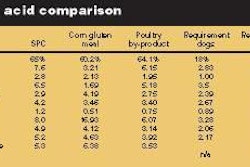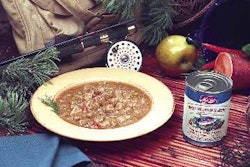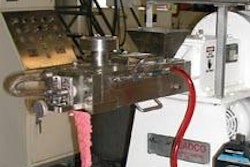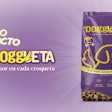In last issue's column, I promised to continue my comments this month concerning the Association of American Feed Control Officials' (AAFCO) Pet Food Committee meeting. There simply was not enough column space last month to discuss the issue of parenthetical statements in ingredient declarations along with the rest of the Committee agenda items. However, as I discovered while writing on the subject, even a whole column devoted to this one topic does not do it justice. Those readers who were not able to attend the 2006 Petfood Forum will be able to find a more thorough treatise on ingredient list parentheticals in the Forum Proceedings. Below is a synopsis of the issues at hand.
Committee concerns
The first of AAFCO Pet Food Committee's two major concerns is when an ingredient, which itself is comprised of two or more ingredients, is declared in the ingredient list. A common means of declaring such an ingredient is to list the ingredient by name, followed parenthetically by each ingredient (except for exempted incidental additives) within that ingredient. The placement of the multi-component ingredient in the list depends on its descending order of predominance for the product as a whole, while the ingredients listed in the parenthetical are declared in their order of predominance in the multi-component ingredient.
While not uncommon, this practice is not recognized as a viable labeling option in the AAFCO Model Pet Food Regulations. Rather, according to the rules, all ingredients must be individually declared in descending order, irrespective of inclusion in the final product by itself or as a component of a multi-component ingredient. This strict AAFCO requirement may be superceded by US Food and Drug Administration (FDA) regulations that do allow use of parentheticals. Still, FDA permits this to be done only under specific conditions, namely, when the multi-component ingredient has an "established" common or usual name or a "standard of identity" promulgated under the authority of FDA or the United States Department of Agriculture.
Unfortunately, formally codified names or identities do not exist for many multi-component ingredients used in petfoods today. As a result, FDA and AAFCO object to the use of parentheticals in many circumstances. For example, describing a separate, discernible component of the food as "pellets" with a parenthetical listing of ingredients within the pellet would not be permitted. The same goes for "pasta" added to a petfood product, although in that case it could be declared by a codified standard of identity that may apply, e.g., "macaroni products."
The Committee's second concern is in regard to "(source of)" statements in ingredient declarations to identify the origin of a nutrient or substance present in the product. As I understand the concern, such parentheticals would be misleading unless every other potential source of that nutrient or substance was similarly identified.
My concerns
In many, many cases, it simply is infeasible for the manufacturer to meet the AAFCO Model Regulations, i.e., to declare each of the ingredients within a multi-component ingredient in their individual respective orders of predominance by weight for the product as a whole. This is because when these ingredients are obtained from an outside supplier, in the vast majority of cases the petfood manufacturer does not know the quantitative proportions of ingredients within that ingredient. Any attempt to declare all ingredients separately is virtually predestined to result in unintentional misrepresentations of relative amounts of ingredients in the final product. Even when the manufacturer does have explicit quantitative information, the mathematics to ensure proper listing in the product as a whole may be extremely and unnecessarily cumbersome at best.
Further, the available standards and established names for multi-component ingredients are very limited in number. For those few that can apply to petfood ingredients, the regulations often use antiquated (or at least, less popular and commonly understood) terms. Hence, a manufacturer may be forced with using the out-of-date terms, affecting not only the ingredient declaration but potentially the identity of the ingredient in the product name and in claims as well. The only option in these cases, and in the multitude of cases where a suitably codified name doesn't exist, is to attempt to adhere to the inflexible listing of each ingredient in the product as a whole, which as explained above is most likely doomed to be inaccurate.
Regarding the "source of" parentheticals, I personally think they are overused today, which serve more to clutter the ingredient list and confuse rather than inform the consumer. However, it's often prudent, if not necessary, to use these on occasion to help support claims elsewhere on the label. True, depending on the situation, they can be misleading, such as when a trivial source is identified by a parenthetical while a much more prominent source of that same nutrient or substance is not identified as a source. However, since a given petfood may contain a large number of ingredients that may contain trace amounts of the named nutrient or substance, requiring all potential sources to be identified only encourages more elaborate, and hence more confusing, ingredient lists.
My suggestions
There appears to be little, if any, concern with use of parentheticals to describe multi-component ingredients on human food labeling, even in cases where an established common or usual name or standard of identity is not used. In fact, although not allowed by strict interpretation of the human food labeling regulations either, the practice has been informally sanctioned in other FDA documents. As a result, the market is replete with examples of this practice, and as far as I can see, they don't deceive or confuse the consumer.
If I wasn't clear in the Petfood Forum 2006 Proceedings, I don't challenge or disagree with the interpretation of the regulations by FDA or AAFCO, nor do I question their motives in making their determination. In fact, I wholeheartedly agree with the goal of the regulators to ensure truthful, non-misleading ingredient label declarations. However, in consideration of practical applications, I respectfully ask for some laxity on this point. My recommendation is to allow parentheticals to describe multi-component ingredients when the ingredient is added as a single ingredient and/or it retains a discernible form in the final product, and the name of the ingredient accurately and in a non-misleading manner describes its basic nature, characterizing property, or discernible form.
My suggestion regarding "source of" parentheticals is to require the identified source of the named nutrient or substance to be the primary source, unless the primary source is also identified. In general, extensive use of these parentheticals should be discouraged, but at the same time judicious use should be recognized as helpful in cases where the ingredient's purpose as a source is not evident from the ingredient name itself.



















